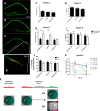The hippocampal CA2 ensemble is sensitive to contextual change
- PMID: 24553945
- PMCID: PMC6608518
- DOI: 10.1523/JNEUROSCI.2563-13.2014
The hippocampal CA2 ensemble is sensitive to contextual change
Abstract
Contextual learning involves associating cues with an environment and relating them to past experience. Previous data indicate functional specialization within the hippocampal circuit: the dentate gyrus (DG) is crucial for discriminating similar contexts, whereas CA3 is required for associative encoding and recall. Here, we used Arc/H1a catFISH imaging to address the contribution of the largely overlooked CA2 region to contextual learning by comparing ensemble codes across CA3, CA2, and CA1 in mice exposed to familiar, altered, and novel contexts. Further, to manipulate the quality of information arriving in CA2 we used two hippocampal mutant mouse lines, CA3-NR1 KOs and DG-NR1 KOs, that result in hippocampal CA3 neuronal activity that is uncoupled from the animal's sensory environment. Our data reveal largely coherent responses across the CA axis in control mice in purely novel or familiar contexts; however, in the mutant mice subject to these protocols the CA2 response becomes uncoupled from CA1 and CA3. Moreover, we show in wild-type mice that the CA2 ensemble is more sensitive than CA1 and CA3 to small changes in overall context. Our data suggest that CA2 may be tuned to remap in response to any conflict between stored and current experience.
Keywords: Arc; CA2; H1a; IEG; context learning; hippocampus.
Figures




Similar articles
-
Memory Reactivation during Learning Simultaneously Promotes Dentate Gyrus/CA2,3 Pattern Differentiation and CA1 Memory Integration.J Neurosci. 2021 Jan 27;41(4):726-738. doi: 10.1523/JNEUROSCI.0394-20.2020. Epub 2020 Nov 25. J Neurosci. 2021. PMID: 33239402 Free PMC article.
-
Differences in hippocampal neuronal population responses to modifications of an environmental context: evidence for distinct, yet complementary, functions of CA3 and CA1 ensembles.J Neurosci. 2004 Jul 21;24(29):6489-96. doi: 10.1523/JNEUROSCI.0350-04.2004. J Neurosci. 2004. PMID: 15269259 Free PMC article.
-
Updating hippocampal representations: CA2 joins the circuit.Trends Neurosci. 2011 Oct;34(10):526-35. doi: 10.1016/j.tins.2011.07.007. Epub 2011 Aug 29. Trends Neurosci. 2011. PMID: 21880379 Review.
-
Routing Hippocampal Information Flow through Parvalbumin Interneuron Plasticity in Area CA2.Cell Rep. 2019 Apr 2;27(1):86-98.e3. doi: 10.1016/j.celrep.2019.03.014. Cell Rep. 2019. PMID: 30943417
-
CA2: A Highly Connected Intrahippocampal Relay.Annu Rev Neurosci. 2020 Jul 8;43:55-72. doi: 10.1146/annurev-neuro-080719-100343. Epub 2019 Dec 24. Annu Rev Neurosci. 2020. PMID: 31874067 Review.
Cited by
-
Hippocampal CA2 activity patterns change over time to a larger extent than between spatial contexts.Neuron. 2015 Jan 7;85(1):190-201. doi: 10.1016/j.neuron.2014.12.001. Neuron. 2015. PMID: 25569350 Free PMC article.
-
Multiparametric imaging hippocampal neurodegeneration and functional connectivity with simultaneous PET/MRI in Alzheimer's disease.Eur J Nucl Med Mol Imaging. 2020 Sep;47(10):2440-2452. doi: 10.1007/s00259-020-04752-8. Epub 2020 Mar 10. Eur J Nucl Med Mol Imaging. 2020. PMID: 32157432 Free PMC article.
-
Diversity of dendritic morphology and entorhinal cortex synaptic effectiveness in mouse CA2 pyramidal neurons.Hippocampus. 2019 Feb;29(2):78-92. doi: 10.1002/hipo.23012. Epub 2018 Nov 25. Hippocampus. 2019. PMID: 30067288 Free PMC article.
-
Role of Hippocampal CA2 Region in Triggering Sharp-Wave Ripples.Neuron. 2016 Sep 21;91(6):1342-1355. doi: 10.1016/j.neuron.2016.08.008. Epub 2016 Sep 1. Neuron. 2016. PMID: 27593179 Free PMC article.
-
Septal cholinergic input to CA2 hippocampal region controls social novelty discrimination via nicotinic receptor-mediated disinhibition.Elife. 2021 Oct 26;10:e65580. doi: 10.7554/eLife.65580. Elife. 2021. PMID: 34696824 Free PMC article.
References
-
- Carninci P, Carninci P, Kasukawa T, Katayama S, Gough J, Frith MC, Maeda N, Oyama R, Ravasi T, Lenhard B, Wells C, Kodzius R, Shimokawa K, Bajic VB, Brenner SE, Batalov S, Forrest AR, Zavolan M, Davis MJ, Wilming LG, et al. The transcriptional landscape of the mammalian genome. Science. 2005;309:1559–1563. doi: 10.1126/science.1112014. - DOI - PubMed
Publication types
MeSH terms
Substances
LinkOut - more resources
Full Text Sources
Other Literature Sources
Molecular Biology Databases
Miscellaneous
